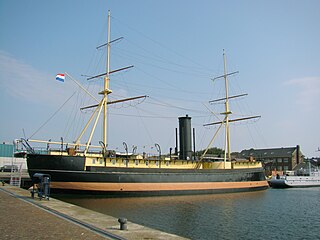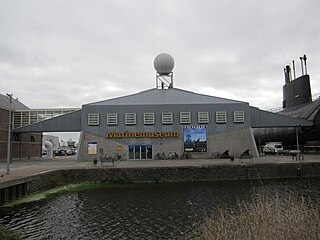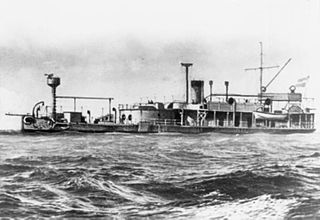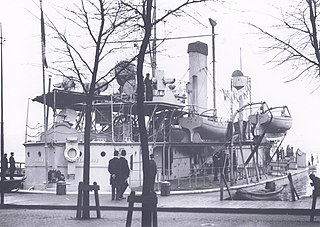Related Research Articles

A monitor is a relatively small warship that is neither fast or strongly armored but carries disproportionately large guns. They were used by some navies from the 1860s, during the First World War and with limited use in the Second World War.

HNLMSBuffel is a 19th-century ironclad ram ship. She was one of the main attractions of the Maritime Museum Rotterdam, also known as the Prince Hendrik Museum, named after its founder, Prince Henry (Hendrik) "The Navigator", who had a naval career and established the basis of the museum back in 1874. In October 2013 the ship moved to Hellevoetsluis and is again open for public.

HNLMS Schorpioen is a Schorpioen-class monitor built in France for the Royal Netherlands Navy in the 1860s. These new ships were equipped with heavy rifled 23 cm (9 in) guns, and a heavy armor. The hull had an armor plated belt of 15 cm (6 in) and the gun turret, housing the two guns, had almost 30 cm (12 in) of armor.

HNLMSBonaire was a fourth-class screw steamship of the Royal Netherlands Navy, now under restoration as a museum ship.

The Dutch Navy Museum is a naval museum in Den Helder, Netherlands.
Buffel might refer to:

HNLMS Guinea was an Buffel-class monitor built for the Royal Netherlands Navy in the early 1870s. Rearmed in 1887 with more modern ordnance, she was sold for scrap in 1897.

HNLMSStier was a Schorpioen-class monitor built in England for the Royal Netherlands Navy in the 1860s.

The Schorpioen-class monitors were a pair of ironclad monitors built abroad for the Royal Netherlands Navy in the 1860s. They had uneventful careers and were stricken from the Navy List in the first decade of the 20th century. Stier became a target ship and was sunk in 1925. Schorpioen was converted into an accommodation ship in 1909. She was captured by the Germans during World War 2, but survived the war. She remained in service until 1982 and then became a museum ship.

The Buffel-class monitors were a pair of ironclad monitors built for the Royal Netherlands Navy in the 1860s. They had uneventful careers and were stricken from the Navy List in the late 1890s. Guinea was scrapped in 1897, but Buffel was hulked and converted into an accommodation ship in 1896. She was captured by the Germans during World War II, but survived the war. She became a museum ship in 1979.
The Adder-class monitors were a group of six ironclad monitors built for the Royal Netherlands Navy in the 1870s.

HNLMS Draak was a monitor, built by the Rijkswerf at Amsterdam for the Royal Netherlands Navy in the late 1870s.

HNLMS Heiligerlee, formerly known as Panter, was a Heiligerlee-class monitor built in England for the Royal Netherlands Navy in the 1860s. Among the new ships built for the Dutch navy Heiligerlee was the first true monitor: a ship with shallow draught, only a few (heavy) guns and decent armor. These characteristics made her very suitable to operate way inland in the Dutch delta.

HNLMS Cerberus, was a Heiligerlee-class monitor built in Amsterdam for the Royal Netherlands Navy in the 1860s. Cerberus was a true monitor: a ship with shallow draught, only a few (heavy) guns and decent armor. These characteristics made her very suitable to operate way inland in the Dutch delta.

The Ever class was a class of 14 flat-iron gunboats of the Royal Netherlands Navy.

The Dutch naval gun 28 cm A No. 1, or 28 cm L/22, was the first of a few 28 cm Breechloader Krupp guns used by the Dutch navy. The 'A' stands for Achterlader, the Dutch word for Breechloader.

HNLMS Matador was a monitor built in the late 1870s.
HNLMS Cerberus may refer to the following ships of the Royal Netherlands Navy that have been named after the mythical creature Cerberus:
